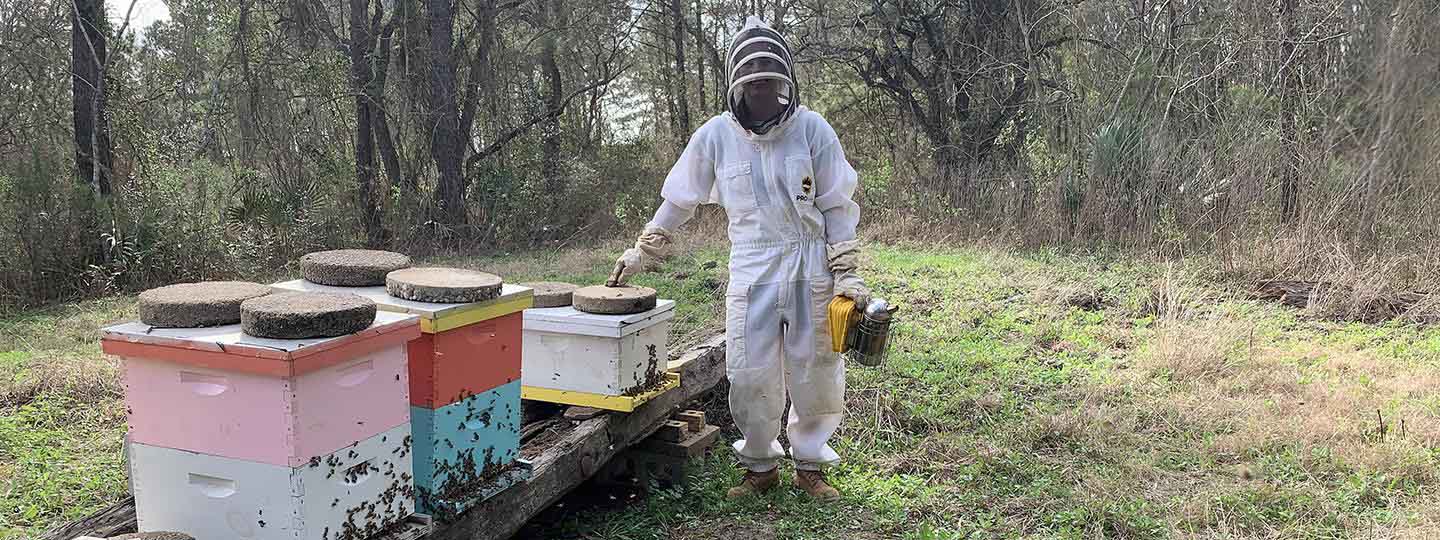Professor finds hobby worth buzzing about

"So are you getting bees this weekend?"
It was not the question Dr. Liana Boop expected her first time attending a Harris County Beekeepers Association meeting. But Boop learned she could either buy bees from a local supplier that weekend or sit tight until next spring.
The San Jacinto College geology professor went from uncommitted to adding her name to the hive order list and a beginner beekeeping kit to her Amazon cart.
"It was a fly-by-my-seat move," she said. "Now or never."
Bumbling beginning
Jumping in, Boop felt like her non-science majors bumbling through college science classes. She bought a package of bees and their queen, a 10-frame hive, and basic equipment like a veil, gloves, and smoker for under $500. After she put the hive in her backyard, trial and error began.
"Unfortunately, to keep bees is to kill bees," she said. "Beginner beekeepers make a lot of mistakes. I had no idea what I was doing."
That was April 2018. Boop's first hive lasted until the following February, when the queen got through the screened board protecting the bottom entrance. Boop tried to get her back inside, but she flew away. The colony collapsed after outside bees robbed the stored honey, its food source.
Lessons learned
Boop admits she didn't know enough in the beginning as she pried into her hives.
"Sometimes you're making split-second decisions," she said. "You don't always have time to check with a mentor or the internet. Sometimes those decisions can help the hive, and sometimes they hurt it."
Expecting good luck can mean killing your bees, so Boop has sought mentors to expand her knowledge.
Last fall, an experienced beekeeper checked her hives and told her they were honey bound: The queen had no place to lay eggs because there was too much honey. Boop needed to harvest honey and replace those frames with empty ones where the queen could lay eggs.
Although some beekeepers lost hives after February's winter storm, Boop's bees survived "triumphantly," thanks to a mentor's help.
While she treats pests with chemicals, Boop resists opening hives in cooler weather. Opening them stresses the bees and — like ripping the weather-stripping off a door — removes the protective seal, a bee-produced resin called propolis.
Honey harvest
Boop now maintains three hives on a friend's property. The hives comprise several wooden file boxes deeps and supers each with 10 vertical frames inside.
She explains it this way: The bees' home is on the first floor, their pantry on the second, and the extra honey stores on top.
In the bottom deep is the brood chamber, where the queen lays her eggs. In the frames above, the bees store pollen and honey, which serve as their winter food source when they can no longer gather.
Above this pantry, Boop adds layers of honey supers, smaller boxes with frames for excess honey. She harvests from these if the hives remain healthy.
The frames have an internal plastic foundation that Boop coats with wax. The bees "draw out the comb" from this wax, forming the hexagonal cells for honey. After storing nectar in their non-digestive stomachs, bees regurgitate the liquid as honey into these cells.
"Fun fact: Honey is bee vomit," she said. "Yum."
Last year Boop finally had enough honey to jar and sell about nine gallons. She posted on Facebook, and within a week, she had sold out.
"It was a strange experience," she said. "People were showing up at my door, giving me cash. Someone as far away as Alabama purchased my honey."
Relaxing rhythm
With time, Boop has settled into a beekeeping rhythm. On average, she spends about an hour a week working on her hives.
On warm weekends when people hide under wide-brimmed hats or retreat to the AC, she plants a lawn chair next to her hives, frosty drink in hand. While she sips, the bees buzz in and out of the hives.
"Going and sitting by my hives is very stress-relieving," she said.
Over the last three years, Boop has learned much about bees themselves. Did you know bees dance to communicate where they've found nectar? Or that they travel up to three miles for nectar, returning with pollen saddlebags on their legs? Or that male drones get kicked out in the fall because they consume resources in winter?
"If you're not pulling your weight, you're out of here," she said, laughing.
Boop has also learned patience and instinct when to step in or step back.
"I finally know enough that I'm not working against my bees," she said.
Photos courtesy of Liana Boop
Interested in beekeeping? Dr. Liana Boop shares these tips before you jump in:
Do your research. Learn to work with the bees instead of against them.
Get a ventilated beekeeping suit. It's hot, especially in summer.
An ideal beekeeper is patient. Learn from your mistakes.
Think about how much you can lift. A 10-frame deep is very heavy when it's full. An
eight-frame or a top-bar hive might be more accessible.
Bees don't need much space, but put the hive in full sun to reduce pests.To Bee or Not to Bee

